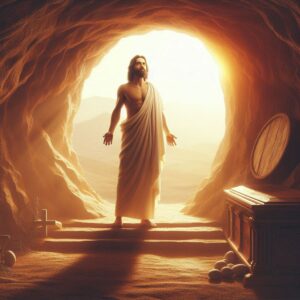As some of you may know, I have become more of a fan of what those in the apologetics community call “The Maximal Data Approach” to defending the resurrection of Jesus. I had an entire 11 part essay series on this blog which eventually was compiled into a book called “The Case For The Reliability Of The Gospels: A Cerebral Faith Blog Book”, which I high recommend reading if you want a robust defense of why Christianity is true, why we can trust that Jesus did indeed claim to be God, died, and rose from the dead, a vindication from God The Father on his ministry and the theological implications that has. I believe the term “Maximal Data Approach” was coined by Dr. Lydia McGrew and while the methodology isn’t new to her, the name suggests that the argument was meant to be a rival to The Minimal Facts Approach championed by Dr. Gary Habermas and Dr. Michael Licona.
A Brief Explanation For Newbies
For the uninitiated, The Minimal Facts Approach (MFA) seeks to establish the resurrection of Jesus using historical facts such as (1) Jesus died by crucifixion, (2) The Empty Tomb, (3) His disciples believed He appeared to them alive after his death, (4) that the church persecutor Saul Of Tarsus converted on the basis of what he perceived to be an appearance of the risen Jesus and (5) Jesus’ skeptical brother James converted on the basis of what he perceived to be an appearance of the risen Jesus. These facts are established by using various “Criteria of Authenticity”, and once established, the resurrection is argued to be the best explanation over and against naturalistic theories. It’s called “Minimal” because the amount of data you are allowed to use is restricted to what has (1) The largest amount of criteria-of-authenticity based arguments in their favor, and (2) are facts that the vast majority of scholars will accept, even non-Christian scholars. It seeks to win the debate while taking a very skeptical bent towards The New Testament documents.
By contrast, The Maximal Data Approach (MDA) seeks to establish these same facts and conclusions, but these Christian Apologists use the gospels as eyewitness testimonies. The gospels are said to be very reliable historical documents, and we can trust what it says when it talks about Jesus. Defenses of its reliability would come from things such as (1) showing how the texts have been reliably transmitted over time, (2) that the gospels were written by the people traditionally ascribed to them (Most of which would have been eyewitnesses such as Matthew and John), (3) The gospels were written extremely early, within a mere 30-35 years after Jesus’ death, (4) Archeology and Extra-Biblical written sources confirm and corroborate many things in the gospels, (5) The criteria of authenticity, when used in a cumulative case, shows that the gospel authors were comitted to telling the truth. (6) Undesigned Coincidences, Unexplained Allusions, and Unnecessary Details show the eyewitness nature of the gospels (features you don’t find in myths or fictions). (7) Alleged Contradictions can be harmonized. Now, as I’ve pointed out in several places, not the least of which is my Defend 2024 conference lecture titled “Making The Maximal Data Argument For Jesus’ Resurrection Attractive”, you don’t need to present ALL of this information to make a powerful and persuasive case for the resurrection. For a short, 15 minute opening statement style presentation, all you really need is to defend the traditional authorship of the gospels, present The McGrewian Trilemma, look at the details of the gospel narratives, and then rule out the lying and mistaken options of the trilemma. The McGrewian Trilemma is named after Lydia McGrew and takes the form of a syllogism
1: The gospel eyewitnesses were either lying, mistaken, or telling the truth.
2: The gospel eyewitnesses were not lying or mistaken.
3: Therefore, the gospel eyewitnesses were telling the truth.
Most of the evidence for reliability is just one long case against that first option. But if you’re short on time, a quick appeal to the extra-biblical accounts of their martyrdoms will suffice.
The Minimal Facts’ Problems With The Details
There is no one “Minimal Facts” argument. There are actually different kinds. One is what Caleb Jackson calls “A Moderate Facts Approach” and is what he defends in his book “Undead: A Historical Investigation Into The Most Famous Miracle In History”. Dr. William Lane Craig uses this approach. A Moderate Facts approach will use the gospels in defending the core facts undergirding the resurrection, but only insofar as the criteria of authenticity can be applied to them. This is the version I’ve defended most of my apologetics career. Then there is an even more minimal facts approach which, some would argue, is more faithful to the MFA philosophy is sticking with scholarly consensus. Michael Licona defends this approach in his book “The Resurrection Of Jesus: A New Historiographical Approach”. This version is extremely reluctant to use any core facts beyond (1) Jesus’ death by crucifixion, (2) The Postmortem Appearances To The Disciples, and (3) The Postmortem Appearance To Paul. No appeal to the empty tomb or the appearance to James.
The Minimal Facts method can establish a lot, surprisingly. But I am beginning to doubt whether it can ground one of the most important facts; the appearances to the disciples. When it comes to eyewitness accounts, especially for invents as amazing, improbable, and spectacular as the resurrection of someone from the dead, the details really matter! Look at any criminal court case. When the prosecutor is interviewing people who claimed to see the defendant murder the victim, they want to make sure that not only are they trustworthy characters, but that they were actually able to clearly make out the murderer. “Was it dark? How well could you see? I see, Mr. Johnson that you wear glasses. Were you wearing your glasses that night? How close or how far away from you?” are some of the questions that will be asked that, depending on their answer, will make or break how strong their testimony is. If the witness says that it was midnight, that the area was barely lit, and they left their glasses in the house, then the possibility that this could be a case of mistaken identity is a good one! How much worse if 11 other witnesses all have such equally subpar views of the suspect! So…what if the postmortem appearances to the disciples happened in a similar way? What if the twelve just thought they saw Jesus because they saw a Jewish rabbi way off in the distance that kind of looked like him? “Is that Jesus?” we might imagine Peter asking. “Yeah, it does look like him!” We can imagine John replying. “Oh! He must be risen from the dead!” We can imagine Matthew saying. And they had, one, maybe two of these “group” appearances. Then later James hallucinated his brother out of guilt for how he treated him during life and mistakenly inferred that Jesus had risen from the dead. And then maybe Paul likewise had some kind of guilt-ridden hallucination.
We know that the appearances to the disciples didn’t happen like this. But we only know this because of the highly detailed accounts in the four gospels. The gospels record lengthy conversations between Jesus and the disciples (Luke 24:13−32; John 20:19−23, 21:1−22). They touched him (Matthew 28:9; Luke 24:39; John 20:27). Jesus ate fish with them on two separate occasions (Luke 24:42-43; John 21:9-13). He appeared to multiple groups, not far away, but close up! Close enough to touch and close enough for Jesus to speak in a normal volume (Matthew 28:9−10; Luke 24:36−43; John 20:19−29). Mary encountered Jesus at the empty tomb and was so close, Jesus reproached her, saying not to cling to his garments (John 20:16−17). And whether Thomas actually did so or not, he at least was invited by the risen Jesus to put his finger in the hole in Jesus’ hands and side (John 20:26−27). This was up close and personal, not some vaguely Jesus-looking Jewish man far away.
These details cause a problem for many of the naturalistic explanations in the mistaken category of The McGrewian Trilemma. And yet, most Minimal Facts arguments lean very, very heavily on the early 1 Corinthians 15 creed. 1 Corinthians 15:3-8 says “For what I received I passed on to you as of first importance: that Christ died for our sins according to the Scriptures, that he was buried, that he was raised on the third day according to the Scriptures, and that he appeared to Cephas, and then to the Twelve. After that, he appeared to more than five hundred of the brothers and sisters at the same time, most of whom are still living, though some have fallen asleep. Then he appeared to James, then to all the apostles, and last of all he appeared to me also, as to one abnormally born.” (NIV)
“He appeared to Cephas”, he appeared “to the twelve”. That’s it. That’s all we’re told. Now, of course, when I read 1 Corinthians 15, I have typically assumed that these were close up and personal encounters. That Jesus probably said some things and did some things. I had pictured, in my mind’s eye, scenes from the canonical gospels (typically as they appeared in Bible movies and paintings) when I read statements like “He appeared to Cephas, then to the twelve”. In other words, my interpretation of 1 Corinthians 15 was colored by my prior knowledge of the gospels’ contents. But what if we got rid of the gospels entirely? What if we pretended these accounts didn’t exist and the creed was all we had? What could we infer? Well, several people had some sort of visual encounter they interpreted as the risen Jesus. But how do we know, as I postulated, that these weren’t very brief sightings of someone who kind of resembled Jesus way off in the distance? Or, what if they hallucinated Jesus so briefly that they saw him for only 3 seconds, He said “Peace be with you. All is well.” and then vanished? Granted, even this would be unlikely in a group setting, but the brevity of it gives an advantage over prolongued, multi-sensory hallucinations on multiple occasions, which is what the skeptic would have to deal with on the gospels’ rendering of these appearances. Apart from the gospels, we don’t know exactly HOW Jesus appeared. Did he appear close up? Did he appear far away? Did he say anything? Did anyone reach out to grab him to make sure he wasn’t a ghost? How long did Jesus stick around before leaving? And the 500, well, that’s a lot of people, but if they also just had some vague image of a man in the distance that kind of looked like Jesus, what’s preventing the “Mass Hysteria” objection from getting off the ground?
We have to face the fact that the details really do matter. The gospels’ rendering of the post-resurrection appearances give us adequate grounds to reject these and pretty much every naturalistic explanation put forth to explain them. But 1 Corinthians 15 does not. This wasn’t Paul’s fault, nor was it the fault of the formulators of the creed he’s citing. This was meant to be a creed; a summary of the beliefs of the early church, not a historical retelling of events.
Can A Minimal Facts Approach Make Use Of Details?
I myself have used arguments from the canonical gospels in such places as my 2019 book “My Redeemer Lives: Evidence For The Resurrection Of Jesus”. However, in retrospect, I do have some misgivings, not the least of which is that I wonder if such arguments don’t fall outside the bounds of the rules of a minimal facts approach. Yes, most skeptical scholars will accept as a historical fact that the disciples experienced something they interpreted to be the risen Jesus, but given their low views of the gospels’ reliability, would they really accept the following argument? “John 20: 24-29 records the postmortem appearance to Thomas. All of the other disciples had seen Jesus alive and were rejoicing at his resurrection, but Thomas was so skeptical of the resurrection that he said that he wouldn’t believe it until he placed his fingers in Jesus’ hands and side. Verses later, we read that Jesus appeared to Thomas and Thomas was convinced. However, why would the writer of the gospel of John depict Thomas in such a bad light? John 20 doesn’t depict one of the apostles in a very good light by making him out to be a hard-headed skeptic, disbelieving the testimony of the rest of the apostles. It seems to me that Thomas’ skepticism is unlikely to be a Christian invention on the basis of the principle of embarrassment. Therefore, this passage is very likely to be telling us a historical fact.” [1]Minton, Evan. My Redeemer Lives: Evidence For The Resurrection Of Jesus (p. 88). Kindle Edition. Not to mention that this presupposes some level of reliability? What is to stop the skeptic from claiming that this story was just embellished over time until “The Johannine Community” included it in the gospel of John? Now, we can dispute that. We can argue for the traditional authorship of John, argue against claims of a Johanine community, etc. But at that point, you’re defending the resurrection like a Maximalist, not a Minimalist! You’ve gone beyond using facts “that the skeptic will grant” and are using data points that, while admittedly well argued, violate the minimal facts policy of what counts as admissible evidence.
Or again, I’ve argued that “Jesus’ after-death appearance to the apostle Peter is independently mentioned by Paul and Luke (1 Corinthians 15: 5; Luke 24: 34). Virtually all scholars agree that Paul and Luke are independent sources. Therefore, the appearance to Peter is multiply attested. The appearance to the Twelve disciples is recorded by Paul, it’s recorded by Luke, and it’s recorded by John (1 Corinthians 15: 5; Luke 24: 36– 53; John 20: 19– 31). Therefore, we have 3 independent sources recording the postmortem appearance to the disciples as a group. Again, what are the odds that 3 independent sources are all going to make up the same lie? On the basis of the principle of multiple attestation, we should conclude that the postmortem appearances are a fact, however you want to explain them.” [2]Minton, Evan. My Redeemer Lives: Evidence For The Resurrection Of Jesus (pp. 87-88). Kindle Edition. However, while the mere fact that a postmortem appearance to the twelve is multiply attested, the specific details are not. Some details, like Jesus eating fish to prove his isn’t a ghost, is only found in one gospel. [3]Technically, Jesus eating fish is recorde in Luke AND John, but these are completely separate meals in completely separate settings. and as I’ve said, the mere fact that the disciples believed they saw him isn’t quite good enough. Saw him how? For how long? How close up? etc.
Perhaps, at this point, one could argue that Luke and John independently record up close and personal conversations, even if they maybe differ on the details, and that is enough to get a criterion of authenticity based argument past the problem of vagueness? On the other hand, we could use the same logic that gets us the empty tomb from the criterion of embarassment to establish and up close and personal interaction between Jesus and Mary Magdalene. On pages 88-89 of my book “My Redeemer Lives”, I make precisely this argument. And it does seem to me that what’s good for the goose is good for the gander. Unfortunately, this would just be an appearance to one individual, and that seems to me to be plausibly explained away by a group hallucination, especially given how distraught Mary is in John’s narrative.
Conclusion
I know. I know. I’m sounding more and more like a McGroupie every day. Trust me, I don’t like it either. However, it does seem to me that a Minimal Facts approach has more severe evidential problems than I had been conceding to the McGrews. Up until this point, I had held that a Minimal Facts Approach could get you crossed the finished line, so to speak. It could do the job in defending the bodily resurrection of Jesus as a historical fact. I simply argued that it was much weaker than The Maximal Data Approach. However, I now fear that Dr. McGrew may be right in saying that it doesn’t even do that much.
I think Dr. Gary Habermas and Dr. Michael Licona need to take these challenges seriously. The problem is that they aren’t. Even when Habermas and Licona go on a radio program specifically to respond to Lydia McGrew, they don’t actually respond to any of her challenges! [4]I am referring to the interview that Braxton Hunter did with Gary Habermas and Michael Licona on Trinity Radio Broadcast a few years ago. Although it partly wasn’t Habermas’ or … Continue reading I think that unless these challenges are dealt with by people who do Minimal Facts arguments, more apologists like myself will stop using the method altogether. If the argument really doesn’t work as the McGrews and McGroupies say, then that would be a good thing. We should only use good, sound arguments. However, much worse is that skeptics might remain unmoved because we’re unnecessarily undermining ourselves by judging which arguments to use on whether skeptical scholars already agree with them. The case for Jesus’ resurrection is not in danger. We simply need to man up and defend the gospels. If you’re used to exclusively using a minimal facts approach, this may require you to go back to school, so to speak, and learn how to defend the resurrection anew. I would recommend my book on gospel reliability (which is $0.99 on Kindle) I mentioned above, Lydia McGrew’s books, Erik Manning’s YouTube channel “Testify”, for some sources to teach you how to do that. There’s also Brant Pitre’s great book “The Case For Jesus”.
References
| ↑1 | Minton, Evan. My Redeemer Lives: Evidence For The Resurrection Of Jesus (p. 88). Kindle Edition. |
|---|---|
| ↑2 | Minton, Evan. My Redeemer Lives: Evidence For The Resurrection Of Jesus (pp. 87-88). Kindle Edition. |
| ↑3 | Technically, Jesus eating fish is recorde in Luke AND John, but these are completely separate meals in completely separate settings. |
| ↑4 | I am referring to the interview that Braxton Hunter did with Gary Habermas and Michael Licona on Trinity Radio Broadcast a few years ago. Although it partly wasn’t Habermas’ or Licona’s fault. Hunter didn’t bring any of the serious objections to the Minimal Facts argument when he had Gary Habermas and Michael Licona on his show. The core objections people like McGrew, Manning, Pallmann, and others have to the MFA, Hunter didn’t even bring up. I didn’t blame Gary Habermas and Michael Liconaa for not dealing with those objections at the time, because all they were doing were responding to the questions posed to them. But the fact remains that it went unaddressed. Click here if you’re interested in listening to the interview. |
Discover more from Cerebral Faith
Subscribe to get the latest posts sent to your email.




